Unveiling Minerals: The Use of Black Light Flashlights
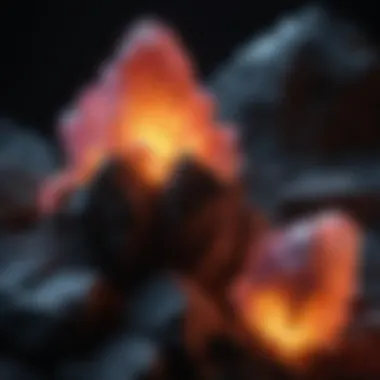
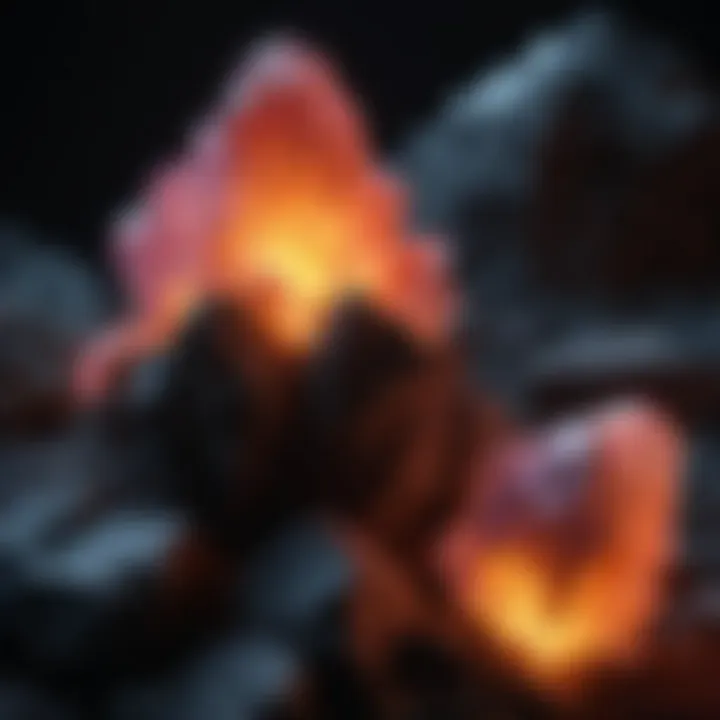
Intro
Rock collecting is a fascinating pursuit that combines science, art, and exploration. Among various tools used by collectors, black light flashlights have emerged as vital instruments. These flashlights help uncover unique characteristics of minerals that are otherwise invisible under regular light. Understanding how to use them effectively can enhance any collector's experience.
History and Origins
Overview of Collectibles, Rocks, and Fossils
The practice of collecting rocks, minerals, and fossils dates back centuries. Individuals have been drawn to the earth's treasures for both aesthetic and scientific purposes. Early collectors often displayed their finds in natural history cabinets, showcasing the beauty and diversity of geological specimens.
As scientific knowledge expanded, the classification and documentation of these collectibles evolved. Tools and methods for identifying minerals emerged, paving the way for a more systematic approach to collecting.
Historical Significance and Cultural Impact
Throughout history, rocks and minerals have played significant roles in various cultures. For instance, ancient Egyptians used lapis lazuli for jewelry, while early civilizations cherished gemstones for their perceived mystical properties. The scientific study of minerals gained traction in the 18th century, with pivotal figures like René Just Haüy contributing to the understanding of crystal structures. Today, rock collecting has transitioned into a more structured hobby, often incorporating modern techniques, such as the use of black light flashlights.
Identification and Classification
Guide to Identifying Rocks and Fossils
To identify rocks and fossils effectively, collectors must observe a range of characteristics. The following features are crucial:
- Color: Observe any vivid hues that stand out.
- Luster: Understand whether the surface reflects light as metallic, glassy, or dull.
- Hardness: Use Mohs scale to evaluate scratch resistance.
- Fluorescence: This is where black light flashlights come into play, revealing hidden properties.
Different minerals exhibit specific fluorescent characteristics. Some, like calcite or fluorite, may glow vibrantly, while others might not fluoresce at all.
Common Types and Variations
Rock collectors encounter various types of specimens, each with its unique traits. Key categories include:
- Igneous Rocks: Formed from cooled lava or magma, often rich in minerals.
- Sedimentary Rocks: Created from sediment accumulation, featuring layers and fossils.
- Metamorphic Rocks: Transformed by heat and pressure, these rocks often display distinct patterns.
- Fossils: Remains of plants or creatures preserved in rock, offering glimpses into Earth's history.
Black light flashlights assist in identifying minerals that fluoresce under ultraviolet light. Collectors might find these properties fascinating, providing deeper insights into their specimens.
"Understanding fluorescence opens a new dimension in rock collecting, revealing hidden beauty and ensuring informed choices in classification."
The journey of rock collecting is enriched by the discovery of these unique properties, empowering collectors to appreciate their finds even more deeply.
Preface to Black Light Flashlights in Rock Collecting
The use of black light flashlights in rock collecting has gained significant attention among enthusiasts and professionals alike. These specialized tools offer unique insights into mineral properties that are otherwise invisible under normal lighting conditions. Their role is not just to illuminate paths but to reveal the hidden wonders of geological specimens. With a proper understanding of these tools, collectors can enhance their field experience and improve their identification skills. Black light flashlights utilize ultraviolet light to expose fluorescence in various minerals, a phenomenon that is crucial for collectors aiming to distinguish between similar-looking specimens.
The Role of Black Light in Geology
The application of black light has important implications in the field of geology. When pointed at certain minerals, these flashlights can cause the specimens to glow in vibrant colors. This fluorescence occurs because certain minerals absorb ultraviolet light and re-emit it as visible light. By examining these reactions, geologists can deduce various properties of the rocks, including their composition and possibly their age. Some minerals exhibit distinctive fluorescing characteristics, making black light an essential tool not only for identification but for enhancing our understanding of geological formations. Therefore, knowing how to effectively use black light can be a game-changer for rock collectors and professionals.
Understanding Fluorescence in Minerals
Fluorescence is a phenomenon where a substance absorbs light and then re-emits it at a different wavelength. In minerals, this can produce breathtaking visual effects and aids in identification. Not all minerals fluoresce; the ability to do so depends on their chemical structure. For instance, minerals such as fluorite and calcite exhibit strong fluorescence when exposed to ultraviolet light. By learning which minerals show this property, rock collectors can significantly refine their collecting techniques. A knowledgeable collector will not only be able to recognize fluorescent minerals but also appreciate the underlying scientific principles that explain these phenomena.
"Fluorescence can reveal qualities of rocks that are not visible in light, allowing for deeper exploration in the hobby."
Types of Black Light Flashlights
The types of black light flashlights are crucial to a collector's experience. Choosing the right model can significantly impact not only the efficiency of rock identification but also the overall enjoyment of the rock collecting hobby. Different models come with unique features that cater to various needs of rock collectors. Understanding these distinctions aids in making an informed decision to enhance your fieldwork.
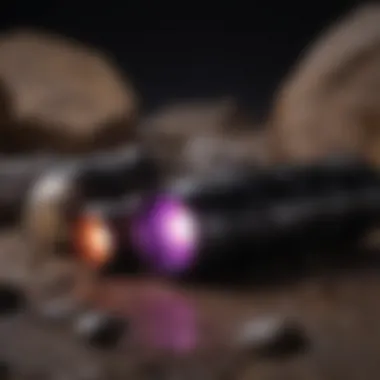
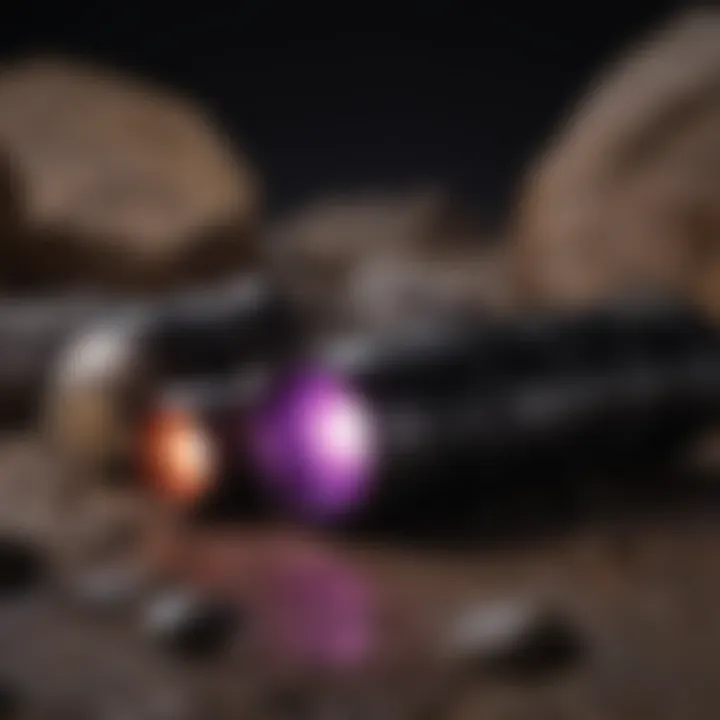
Handheld vs. Rechargeable Models
Handheld models offer simplicity and portability. They are often lightweight, making them ideal for fieldwork where mobility is necessary. Many collectors prefer a handheld unit for spontaneous mineral hunting as these models can be stored easily and deployed quickly. They often run on batteries, which can be a double-edged sword. While replacing batteries is straightforward, it can be inconvenient when power runs out unexpectedly.
Rechargeable models, on the other hand, typically provide a more cost-effective solution in the long run. They reduce waste associated with disposable batteries and often deliver more consistent brightness over time. Additionally, many rechargeable units come with an indicator for battery life. However, they may require a more extended initial charging time before first use. Choosing between these two options involves considering personal preferences and the nature of collecting experiences.
LED Technology in Black Light Devices
LED technology has revolutionized black light devices in recent years. LEDs are known for their exceptional energy efficiency. They produce brighter light per watt compared to traditional incandescent bulbs. This higher efficiency equals longer use between charges or battery replacements. The spectrum of light emitted by LEDs is tuned for excellent visibility of fluorescent minerals, making them especially effective.
Moreover, LEDs tend to have longer lifespans. A standard LED can last several years if used correctly. This durability is advantageous for individuals who frequently go out in the field. Collectors can rely on LED black lights without fearing frequent burnout.
In summary, selecting the right type of black light flashlight is vital for rock collectors. Handheld models are about convenience, while rechargeable models focus on sustainability. The introduction of LED technology means that collectors can now benefit from brighter, longer-lasting, and more efficient light sources, which are indispensable when exploring minerals. Keep these considerations in mind as you seek the best tools for your rock collecting endeavors.
Identifying Rocks with Black Light
Identifying rocks using black light is a pivotal subject within the context of rock collecting. Fluorescence is a unique property of certain minerals, allowing collectors to uncover hidden aspects of their specimens. By harnessing the power of black light flashlights, collectors can enhance their field experience and improve their identification skills.
When it comes to rock collecting, understanding which minerals fluoresce under black light is essential. This allows collectors to spot potential specimens that would otherwise remain unnoticed. Each mineral has distinct fluorescent characteristics; knowing these traits can significantly enhance the efficiency of a collector's search. This not only adds to the excitement of the hunt but can also lead to discovering valuable specimens that are rarely seen in natural light.
In addition to identifying minerals, the use of black light allows for a deeper understanding of geological history. By observing how different rocks respond to ultraviolet light, collectors can learn more about the conditions under which these minerals formed. Thus, the utility of black light extends beyond mere identification—it contributes to a richer understanding of geology as a whole.
Fluorescent Minerals to Look For
When utilizing black light in the field, certain minerals are particularly noteworthy due to their vivid fluorescence. The following list highlights some of the most common minerals collectors should be mindful of:
- Fluorite: This mineral is often bright and shows blue, green, or yellow hues under UV light.
- Calcite: Calcite can exhibit a range of colors from red to orange when viewed with a black light.
- Selenite: Known for its bright luminescence, selenite can appear green or orange under UV rays.
- Willemite: This mineral can display a striking green fluorescence that is easily identifiable.
- Scheelite: Often showing a blue glow, scheelite is another mineral that can be recognized under black light.
Identifying these minerals can significantly enhance a collector's experience, providing a thrilling sense of discovery.
Techniques for Effective Inspection
To maximize the benefits of using black light when identifying rocks, collectors should consider employing specific techniques during their inspection process. Here are some effective methods:
- Control the Viewing Area: It is crucial to minimize ambient light when using black light. This can typically be achieved by conducting inspections in dark or shaded areas.
- Monitor Optimal Angle: The angle at which the black light is held relative to the specimen can greatly influence the visibility of fluorescence. Adjust throughout the inspection for the best view.
- Use a White Light Backup: Having a regular flashlight can help to pick up other identifying characteristics of rocks that might not fluoresce under black light.
- Document Findings: Keep a record of specimens that fluoresce and the conditions under which they were found. This practice can aid in refining searching techniques and enhance overall rock collecting knowledge.
By employing these techniques, rock collectors can make the most of their black light flashlights and further deepen their understanding of mineral properties. The combination of knowledge, skill, and appropriate equipment can transform the experience of rock collecting.
Practical Usage of Black Light Flashlights
The utilization of black light flashlights is crucial for rock collectors who seek deeper insights into the geological specimens they encounter. These specialized tools allow for the identification of fluorescent minerals, which are often overlooked under regular lighting. The ability to reveal hidden properties can significantly enhance the collecting experience and increase the overall value of findings. Understanding how to practically use these flashlights transforms a simple collection activity into a more informed and rewarding pursuit.
Setting Up Your Field Equipment
Setting up your field equipment effectively is crucial for maximizing the benefits of black light flashlights. First, ensure your flashlight is in good working condition. Check the batteries and the bulb, as malfunctions can lead to missed opportunities. Select a sturdy backpack to carry your flashlight along with other essential tools such as a field guide, collecting bags, and safety glasses. Furthermore, consider organizing your gear in a way that allows for quick access.
When you arrive at your collecting site, assess the area. It is best to choose a location with limited ambient light, as this will allow the black light's effectiveness to shine through. Position yourself so that your field equipment is easy to use. Hold the flashlight stable at a consistent angle to the rocks you are inspecting. This ensures the light interacts properly with the minerals.
Pro Tip: Always carry spare batteries to avoid frustration during your fieldwork.
Safety Considerations When Using Black Light
Safety should be a top priority when using black light flashlights. Although these devices are generally safe, there are several considerations to keep in mind. First, prolonged exposure to ultraviolet light can be harmful to your eyes and skin. It is advisable to wear UV-blocking sunglasses and long sleeves when working in the field.
Additionally, keep your flashlight away from reflective surfaces and minimize the time spent in direct beam exposure. Always inspect your equipment before use for any damaged wiring or faulty bulbs, as this can pose fire hazards and lead to accidents.


In terms of general field safety, be aware of your surroundings. Remote collecting sites can have hidden dangers. Always have a plan in place for emergencies, including informing someone of your location and return time.
Integrating these practical usage tips will not only enhance your effectiveness as a rock collector but also ensure you engage safely with your environment.
Comparing Traditional and Black Light Flashlights
When it comes to rock collecting, the tools you choose can greatly influence your success in identifying minerals. Comparing traditional flashlights with black light flashlights reveals significant differences in functionality and purpose. It is essential to understand these differences to make informed decisions when equipping yourself for fieldwork. The specific elements of brightness, wavelength, and application contexts need to be considered carefully.
Advantages of Black Light Over Regular Flashlights
Black light flashlights operate differently than standard flashlights. Here are some advantages:
- Fluorescence Detection: Black light flashlights emit ultraviolet (UV) light, which can cause certain minerals to fluoresce. This property allows collectors to identify unique specimens that would remain hidden under regular lighting.
- Enhanced Color Visibility: Regular flashlights typically emit white light, which can obscure the subtle color variations of minerals. Black light enhances these color differences, allowing for better identification of certain minerals like calcite or fluorite.
- Portability and Convenience: Many black light models, such as the UVBEAM UV flashlight or the Streamlight 51010, are lightweight and easy to carry. Their portability makes them ideal for collectors who often traverse uneven terrains or remote locations to search for specimens.
"The use of black light flashlights in rock collecting not only opens new possibilities for discovery but also enriches the overall collecting experience."
By understanding the specific benefits of black light, collectors can better appreciate how it can enhance their fieldwork and identifying abilities.
Cost Considerations
Buying the right equipment involves a range of cost factors. Black light flashlights can be more expensive than traditional models, but many collectors find the investment worthwhile. Here are some cost-related elements to keep in mind:
- Initial Investment: Models like the Nebo 6150 or the ultra violet flashlight by Energizer may require a higher initial cost, especially when compared to cheap traditional flashlights.
- Durability and Longevity: Black light flashlights are often built with robust materials designed for outdoor use. A higher upfront cost can sometimes mean a more durable product, which can save money over time.
- Versatility: Investing in a quality black light can serve multiple purposes beyond rock collecting, such as forensics, art restoration, or even indoor pest control. This versatility can justify the cost for many users.
In summary, while traditional flashlights may be readily available and less expensive, black light flashlights present substantial advantages in mineral identification and longevity. Being informed about the comparative costs and benefits equips rock collectors to make more strategic purchasing decisions.
Best Practices for Rock Collecting with Black Light
Using black light flashlights effectively can significantly enhance the experience of rock collecting. This section will delve into the specific practices that collectors should adopt to maximize their success and enjoyment while using this specialized lighting. Understanding how to integrate black light into your routine not only improves mineral identification but also fosters a more organized approach to collecting. Here are some essential best practices to consider.
Integrating Black Light into Your Collecting Routine
The integration of black light into your field routine can be transformative. Before going to your collecting site, ensure your flashlight is fully charged or has fresh batteries. It’s prudent to carry a spare flashlight, especially in remote locations. This avoids disappointment should your primary device fail. You should plan your visits during times when the effects of fluorescence can be observed most clearly, typically at dusk or dawn.
While in the field, start by scoping out areas known for fluorescent minerals, such as certain rock formations or quarries. Aim your flashlight at the ground and observe the minerals' reactions. Some rocks may appear dull under normal light but will show vibrant colors under black light.
A systematic approach is beneficial. Consider creating a grid pattern in your site inspection, ensuring that no area goes unchecked. Use a notebook to jot down observations and reactions, noting the colors and characteristics that different minerals exhibit. This structured method will lead to a deeper understanding of the surroundings. Furthermore, if working in a group, share your findings and techniques to improve overall collection practices.
Documentation and Record Keeping
Keeping thorough records is crucial for any serious rock collector utilizing black light flashlights. Documenting your findings not only helps in cataloging your collection but also contributes to a broader understanding of mineral distributions and properties in specific areas.
When recording your observations, consider the following aspects:
- Date and Time: Note when you collected specific specimens, as this can help identify seasonal variations in fluorescence.
- Location: Map the coordinates or write down the specific location near landmarks. This information is essential for returning to the same spot or for sharing findings in forums.
- Mineral Characteristics: Record details such as color, clarity, and UV response. Some minerals may show weak fluorescence under certain UV wavelengths but may react strongly under others.
Additionally, photographs can be a powerful tool. Capture images of specimens under both regular light and black light. This visual documentation will add depth to your records and aid in future identifications. Online platforms, such as Reddit or specialized rock collecting forums, can serve as valuable spaces for sharing findings, images, and techniques with fellow collectors.
By adopting these practices, rock collectors can elevate their experience with black light flashlights, enhancing both personal enjoyment and their contributions to the geological community.
Challenges and Limitations
The use of black light flashlights for rock collecting brings unique challenges and limitations that collectors, both novice and experienced, should understand. Acknowledging these concerns enhances the overall effectiveness and enjoyment of using black light in the field. Addressing the challenges can help prevent frustration and ensure a positive experience while facilitating better decision-making when using these specialized tools.
Dependence on Environmental Conditions
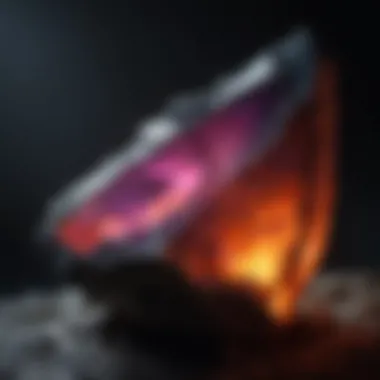
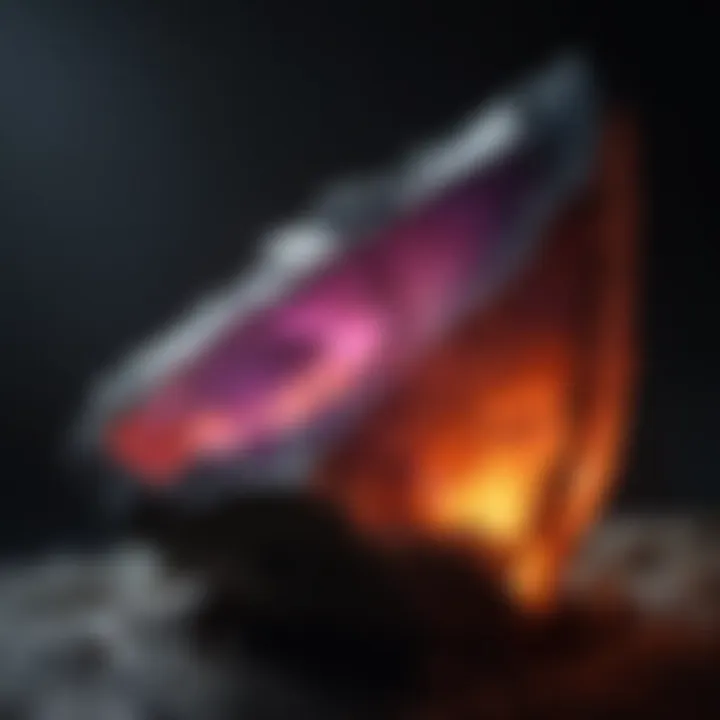
One significant challenge encountered when using black light flashlights is the dependence on environmental conditions. Factors such as ambient light, humidity, and the surrounding landscape can greatly influence the visibility and efficacy of fluorescence detection.
For instance, searching for fluorescent minerals in bright daylight can make it nearly impossible to see any glowing features. It is advisable to conduct searches during dusk or in shaded areas when natural light is minimal. Moreover, wet environments can affect how minerals fluoresce. Sometimes, moisture ignites hidden features, while in other instances, it can obscure fluorescence entirely.
Additionally, regions with high light pollution or urban settings may hamper the identification of fluorescent minerals. Collectors should select locales with minimal artificial lighting for optimal results. Thus, understanding how various environmental conditions affect the way minerals fluoresce can significantly improve field outcomes.
Potential Misidentification of Minerals
Another factor to consider is the potential misidentification of minerals when using black light flashlights. This issue can lead to incorrect conclusions about the rocks collected. Fluorescence can sometimes mislead observers, as many minerals exhibit similar glowing characteristics under black light.
Some common examples include minerals like calcite and fluorite, which both can fluoresce in varying colors, creating challenges for accurate identification. It is crucial to approach each specimen with a level of caution and to cross-reference findings with physical characteristics visible under normal lighting.
To mitigate misidentification, collectors should do the following:
- Educate Themselves: Familiarize themselves with the common fluorescent minerals and their features prior to field trips.
- Use Multiple Methods: Combine black light inspection with other identification techniques, such as mineral hardness tests or color observations in natural light.
- Seek Expert Guidance: Engage with rock collecting communities via online forums or local clubs to gather insights from seasoned collectors.
Community and Resources
In the world of rock collecting, engaging with a community can significantly enhance both knowledge and experience. This segment elaborates on the value of connecting with others who share an interest in geology and mineralogy. Communities not only offer support but also foster the sharing of insights and techniques. The collective knowledge available in forums and groups can prove invaluable, particularly for beginners who may feel daunted by the depth of information surrounding the hobby.
Furthermore, these networks provide a platform to exchange resources, such as black light flashlight recommendations, mineral identification methods, and field experiences. Community engagement promotes a culture of learning, encouraging members to share discoveries and potential pitfalls, thus enhancing the rock collecting journey.
"Involvement in a supportive community can elevate the rock collecting experience, providing a wealth of information and friendship."
Forums and Groups for Rock Collectors
The rise of online forums and social media groups has revolutionized the way hobbyists connect and share their passion for rock collecting. Websites like Reddit host specialized subreddits, where users can discuss their most recent finds, post photographs, and seek advice on specific minerals. Additionally, Facebook has numerous groups dedicated to rock collectors, where members post questions, host discussions, and schedule meetups.
Some popular online platforms include:
- Reddit's r/minerals
- Facebook groups like "Rock Collecting" and "Mineral Collectors"
- Online forums like Mindat.org
These spaces not only allow for interaction on a global scale but also create localized groups where collectors can meet in person. By participating in these forums, rock collectors gain access to real-time information about finds and methodologies, enriching their geological understanding.
Recommended Literature and Guides
Books and manuals serve as crucial resources for both novice and seasoned rock collectors. Well-researched literature can offer guidance on proper field techniques, mineral identification, and even detailed descriptions of fluorescence in geological specimens. A few noteworthy titles in this niche include:
- "The Rock Collector’s Guide" by Michael K. Smith: An essential read for anyone serious about their collection.
- "Fluorescent Minerals and Their Localities" by George V. Robinson: A comprehensive exploration of fluorescence relevant to rock collectors.
- "Rocks, Minerals, and Gemstones" by Charles E. Jenkins: This guide serves as an excellent reference for identification and deeper understanding.
Utilizing these texts can vastly improve a collector's knowledge and ability to make accurate identifications. Establishing a foundational understanding will enhance the use of black light flashlights in the field. Collectors should also seek out practical guides focusing specifically on the use of black light technology in mineral identification, as it is a valuable tool in discovering hidden features of rocks and minerals.
Culmination and Future Trends
As we conclude our exploration of black light flashlights in rock collecting, it is essential to evaluate how emerging technologies and community contributions shape the future of this field. The relevance of continuous innovation cannot be overstated. It unlocks new possibilities for both novice and expert collectors, enhancing their understanding and experience in identifying and studying minerals.
Emerging Technologies in Rock Collecting
The fusion of technology with geology is rapidly progressing. Newer models of black light flashlights incorporate improved LED technology, offering higher efficiency and longer battery life. These advancements help geologists and collectors work longer hours in the field without worrying about diminishing performance.
Moreover, the integration of smartphone apps with black light technology shows great promise. These apps can assist in identifying minerals by comparing real-time photographs of the specimens against databases of known samples. This allows for faster and more accurate identification, which is particularly beneficial in areas where many similar-looking minerals may exist. The rise of portable spectrometers is another noteworthy shift; they can analyze the light spectrum emitted by a mineral under a black light, further aiding in precise identification.
The continued development of personal protective equipment that works effectively under UV light will likely increase in importance. Collectors may be more inclined to utilize black light flashlights if they feel safe and protected from potential hazards. Improved gear and increased knowledge about safety can significantly upgrade the field experience.
Contributions to Scientific Community
Black light flashlights also hold a place in the broader scientific community. Their utility extends beyond amateur collectors, as researchers often utilize these tools to study mineral properties more closely. Contributions such as detailed findings from rock collectors can add to a repository of knowledge concerning mineral fluorescence, helping to refine existing classifications and insights about geological formations.
The discussions and discoveries shared on platforms like Reddit or through specialized forums can foster collaboration among enthusiasts and experts alike. This dynamic interchange of ideas not only encourages collective learning but also enhances public understanding of geology and mineralogy. Furthermore, the documentation practices of rock collectors enrich databases that scientists might reference in their work. This relationship between hobbyists and professionals strengthens the understanding within geosciences.
"Innovation in tools and community efforts together groups lead to enriched understandings and discoveries that enhance geological science itself."
In summary, the intersection of technology and community engagement in rock collecting is expanding. As tools become more advanced, and as datasets grow richer, the implications for both practical collection techniques and scientific inquiry are significant. Looking ahead, enthusiasts should take note; the advancements in technology and collaboration will undoubtedly offer new horizons for rock collecting and study.



